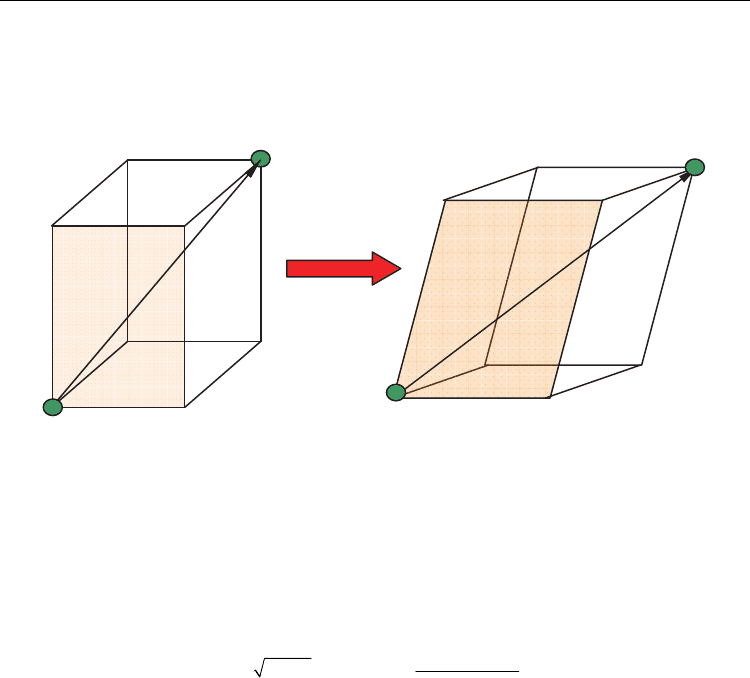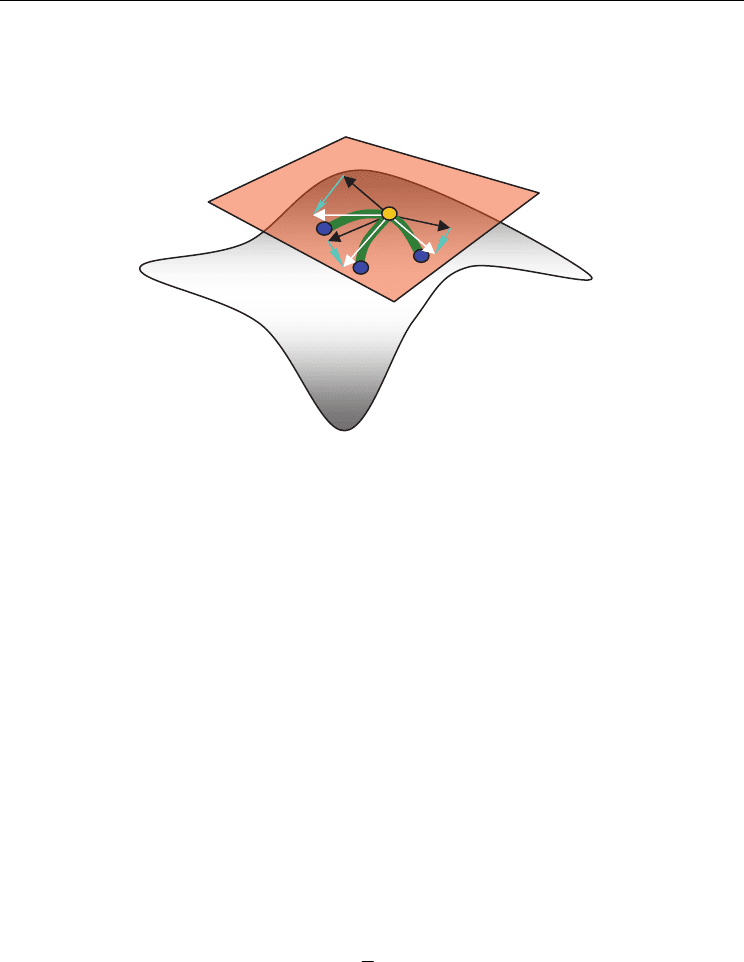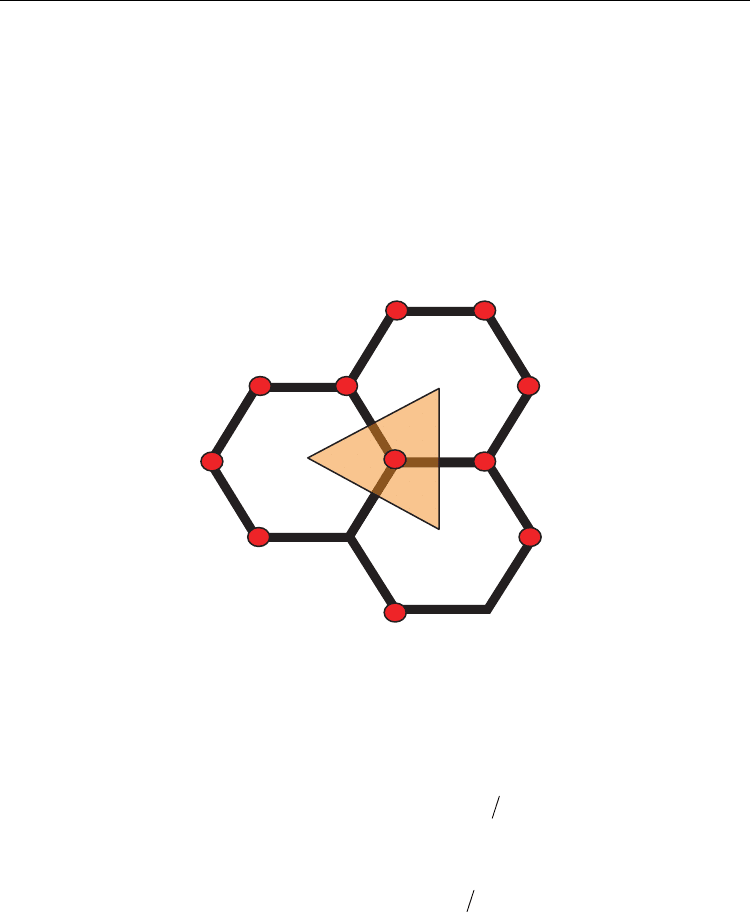Yellampalli S. (ed.) Carbon Nanotubes - Synthesis, Characterization, Applications
Подождите немного. Документ загружается.

Part 2
Characterization & Properties of CNTs
11
Study of Carbon Nanotubes Based
on Higher Order Cauchy-Born Rule
Jinbao Wang
1,2
,
Hongwu Zhang
2
, Xu Guo
2
and Meiling Tian
1
1
School of Naval Architecture & Civil Engineering, Zhejiang Ocean University,
2
State Key Laboratory of Structural Analysis for Industrial Equipment,
Department of Engineering Mechanics, Faculty of Vehicle Engineering and Mechanics,
Dalian University of Technology,
P.R.China
1. Introduction
Since single-walled carbon nanotube (SWCNT) and multi-walled carbon nanotube
(MWCNT) are found by Iijima (1991, 1993), these nanomaterials have stimulated extensive
interest in the material research communities in the past decades. It has been found that
carbon nanotubes possess many interesting and exceptional mechanical and electronic
properties (Ruoff et al., 2003; Popov, 2004). Therefore, it is expected that they can be used as
promising materials for applications in nanoengineering. In order to make good use of these
nanomaterials, it is important to have a good knowledge of their mechanical properties.
Experimentally, Tracy et al. (1996) estimated that the Young’s modulus of 11 MWCNTs vary
from 0.4TPa to 4.15TPa with an average of 1.8TPa by measuring the amplitude of their
intrinsic thermal vibrations, and it is concluded that carbon nanotubes appear to be much
stiffer than their graphite counterpart. Based on the similar experiment method, Krishnan et
al. (1998) reported that the Young’s modulus is in the range of 0.9TPa to 1.70TPa with an
average of 1.25TPa for 27 SWCNTs. Direct tensile loading tests of SWCNTs and MWCNTs
have also been performed by Yu et al. (2000) and they reported that the Young’s modulus
are 0.32-1.47TPa for SWCNTs and 0.27-0.95TPa for MWCNTS, respectively. In the
experiment, however, it is very difficult to measure the mechanical properties of carbon
nanotues directly due to their very small size.
Based on molecular dynamics simulation and Tersoff-Brenner atomic potential, Yakobson et
al. (1996) predicted that the axial modulus of SWCNTs are ranging from 1.4 to 5.5 TPa (Note
here that in their study, the wall thickness of SWNT was taken as 0.066nm); Liang &
Upmanyu (2006) investigated the axial-strain-induced torsion (ASIT) response of SWCNTs,
and Zhang et al. (2008) studied ASIT in multi-walled carbon nanotubes. By employing a
non-orthogonal tight binding theory, Goze et al. (1999) investigated the Young’s modulus of
armchair and zigzag SWNTs with diameters of 0.5-2.0 nm. It was found that the Young’s
modulus is dependent on the diameter of the tube noticeably as the tube diameter is small.
Popov et al. (2000) predicted the mechanical properties of SWCNTs using Born’s
perturbation technique with a lattice-dynamical model. The results they obtained showed
that the Young’s modulus and the Poisson’s ratio of both armchair and zigzag SWCNTs
depend on the tube radius as the tube radius are small. Other atomic modeling studies

Carbon Nanotubes - Synthesis, Characterization, Applications
220
include first-principles based calculations (Zhou et al., 2001; Van Lier et al., 2000; Sánchez-
Portal et al., 1999) and molecular dynamics simulations (Iijima et al., 1996). Although these
atomic modeling techniques seem well suited to study problems related to molecular or
atomic motions, these calculations are time-consuming and limited to systems with a small
number of molecules or atoms.
Comparing with atomic modeling, continuum modeling is known to be more efficient from
computational point of view. Therefore, many continuum modeling based approaches have
been developed for study of carbon nanotubes. Based on Euler beam theory, Govinjee and
Sackman (1999) studied the elastic properties of nanotubes and their size-dependent
properties at nanoscale dimensions, which will not occur at continuum scale. Ru (2000a,b)
proposed that the effective bending stiffness of SWCNTs should be regarded as an
independent material parameter. In his study of the stability of nanotubes under pressure,
SWCNT was treated as a single-layer elastic shell with effective bending stiffness. By
equating the molecular potential energy of a nano-structured material with the strain energy
of the representative truss and continuum models, Odegard et al. (2002) studied the
effective bending rigidity of a graphite sheet. Zhang et al. (2002a,b,c, 2004) proposed a
nanoscale continuum theory for the study of SWCNTs by directly incorporating the
interatomic potentials into the constitutive model of SWCNTs based on the modified
Cauchy-Born rule. By employing this approach, the authors also studied the fracture
nucleation phenomena in carbon nanotubes. Based on the work of Zhang (2002c), Jiang et al.
(2003) proposed an approach to account for the effect of nanotube radius on its mechanical
properties. Chang and Gao (2003) studied the elastic modulus and Poisson’s ratio of
SWCNTs by using molecular mechanics approach. In their work, analytical expressions for
the mechanical properties of SWCNT have been derived based on the atomic structure of
SWCNT. Li and Chou (2003) presented a structural mechanics approach to model the
deformation of carbon nanotubes and obtained parameters by establishing a linkage
between structural mechanics and molecular mechanics. Arroyo and Belytschko (2002,
2004a,b) extended the standard Cauchy-Born rule and introduced the so-called exponential
map to study the mechanical properties of SWCNT since the classical Cauchy-Born rule
cannot describe the deformation of crystalline film accurately. They also established the
numerical framework for the analysis of the finite deformation of carbon nanotubes. The
results they obtained agree very well with those obtained by molecular mechanics
simulations. He et al. (2005a,b) developed a multishell model which takes the van der Waals
interaction between any two layers into account and reevaluated the effects of the tube
radius and thickness on the critical buckling load of MWCNTs. Gartestein et al. (2003)
employed 2D continuum model to describe a stretch-induced torsion (SIT) in CNTs, while
this model was restricted to linear response. Using the 2D continuum anharmonic
anisotropic elastic model, Mu et al. (2009) also studied the axial-induced torsion of
SWCNTs.
In the present work, a nanoscale continuum theory is established based on the higher order
Cauchy-Born rule to study mechanical properties of carbon nanotubes (Guo et al., 2006;
Wang et al., 2006a,b, 2009a,b). The theory bridges the microscopic and macroscopic length
scale by incorporating the second-order deformation gradient into the kinematic
description. Our idea is to use a higher-order Cauchy-Born rule to have a better description
of the deformation of crystalline films with one or a few atom thickness with less
computational efforts. Moreover, the interatomic potential (Tersoff 1988, Brenner 1990) and

Study of Carbon Nanotubes Based on Higher Order Cauchy-Born Rule
221
the atomic structure of carbon nanotube are incorporated into the proposed constitutive
model in a consistent way. Therefore SWCNT can be viewed as a macroscopic generalized
continuum with microstructure. Based on the present theory, mechanical properties of
SWCNT and graphite are predicted and compared with the existing experimental and
theoretical data.
The work is organized as follows: Section 2 gives Tersoff-Brenner interatomic potential for
carbon. Sections 3 and 4 present the higher order Cauchy-Born rule is constructed and the
analytical expressions of the hyper-elastic constitutive model for SWCNT are derived,
respectively. With the use of the proposed constitutive model, different mechanical
properties of SWCNTs are predicted in Section 5. Finally, some concluding remarks are
given in Section 6.
2. The interatomic potential for carbon
In this section, Tersoff-Brenner interatomic potential for carbon (Tersoff, 1988; Brenner,
1990), which is widely used in the study of carbon nanotubes, is introduced as follows.
() () ()
IJ R IJ IJ A IJ
Vr V r BV r
(1)
Where
2( ) 2/( )
() () , () ()
11
ee
s
β
rr s
β
rr
ee
RA
DDS
Vr fr e Vr fr e
SS
(2)
1
1
1
2
0
1
21
()
()
()
rr
fr
rr
1
12
2
rr
π
cos r r r
rr
(3)
(,)
1()()
δ
IJ IJK IK
KIJ
BGθ fr
(4)
22
00
0
22 2
00
() 1
(1 )
cc
G θ a
dd θ
cos
(5)
with the constants given in the following.
1
6 000 , 1 22, 21 , 0 1390.eV . .
ee
DS
β
nm r nm
0 50000 ,.δ
0 00020813 , 330 , 3 5..
000
acd
3. The higher order cauchy-born rule
Cauchy-Born rule is a fundamental kinematic assumption for linking the deformation of the
lattice vectors of crystal to that of a continuum deformation field. Without consideration of

Carbon Nanotubes - Synthesis, Characterization, Applications
222
diffusion, phase transitions, lattice defect, slips or other non-homogeneities, it is very
suitable for the linkage of 3D multiscale deformations of bulk materials such as space-filling
crystals (Tadmor et al., 1996; Arroyo and Belytschko, 2002, 2004a,b). In general, Cauchy-
Born rule describes the deformation of the lattice vectors in the following way:
Fig. 1. Illustration of the Cauchy-Born rule
bFa (6)
where
F is the two-point deformation gradient tensor, a denotes the undeformed lattice
vector and
b represents the corresponding deformed lattice vector (see Fig. 1 for reference).
In the deformed crystal, the length of the deformed lattice vector and the angle between two
neighboring lattice vectors can be expressed by means of the standard continuum mechanics
relations:
baCa and cos
|| |||| ||
aCa
bb
(7)
where
bFa (
b
and
a
denote the neighboring deformed and undeformed lattice
vector, respectively) and
T
CF F is the Green strain tensor measured from undeformed
configuration.
represents the angle formed by the deformed lattice vectors b and
b .
Though the use of Cauchy-Born rule is suitable for bulk materials, as was first pointed out
by Arroyo and Belytschko (2002; 2004a,b), it is not suitable to apply it directly to the curved
crystalline films with one or a few atoms thickness, especially when the curvature effects are
dominated. One of the reasons is that if we view SWCNT as a 2D manifold without
thickness embedded in 3D Euclidean space, since the deformation gradient tensor
F
describes only the change of infinitesimal material vectors emanating from the same point in
the tangent spaces of the undeformed and deformed curved manifolds, therefore the
deformation gradient tensor
F
is not enough to give an accurate description of the length of
the deformed lattice vector in the deformed configuration especially when the curvature of
the film is relatively large. In this case, the standard Cauchy-Born rule should be modified to
give a more accurate description for the deformation of curved crystalline films, such as
carbon nanotubes.
bFa
a

Study of Carbon Nanotubes Based on Higher Order Cauchy-Born Rule
223
In order to alleviate the limitation of Cauchy-Born rule for the description of the
deformation of curved atom films, we introduce the higher order deformation gradient into
the kinematic relationship of SWCNT. The same idea has also been shown by Leamy et al.
(2003).
Fig. 2. Schematic illustration of the higher order Cauchy-Born rule
From the classical nonlinear continuum mechanics point of view, the deformation gradient
tensor
F is a linear transformation, which only describes the deformation of an infinitesimal
material line element d
X in the undeformed configuration to an infinitesimal material line
element d
x in deformed configuration, i.e.
dd
xF X (8)
As in Leamy et al. (2003), by taking the finite length of the initial lattice vector
a
into
consideration, the corresponding deformed lattice vector should be expressed as:
()d
a
0
bFss (9)
Assuming that the deformation gradient tensor
F is smooth enough, we can make a
Taylor’s expansion of the deformation field at
s 0 , which is corresponding to the starting
point of the lattice vector a .
3
() () () ():( )/2 (||||) Fs F F s F s s s00 0 O
(10)
Retaining up to the second order term of s in (10) and substituting it into (9), we can get the
approximated deformed lattice vector as:
1
() ():( )
2
bF a F a a00
(11)
Comparing with the standard Cauchy-Born rule, it is obvious that with the use of this
higher order term, we can pull the vector
Fa more close to the deformed configuration
(see Fig. 2 for an illustration). By retaining more higher-order terms, the accuracy of
Tangent planar
Current configuration

Carbon Nanotubes - Synthesis, Characterization, Applications
224
approximation can be enhanced. Comparing with the exponent Cauchy-Born rule proposed
by Arroyo and Belytschko (2002, 2004a,b), it can improve the standard Cauchy-Born rule for
the description of the deformation of crystalline films with less computational effort.
4. The hyper-elastic constitutive model for SWCNT
With the use of the above kinematic relation established by the higher order Cauchy-Born
rule, a constitutive model for SWCNTs can be established. The key idea for continuum
modeling of carbon nanotube is to relate the phenomenological macroscopic strain energy
density
0
W per unit volume in the material configuration to the corresponding atomistic
potential.
Fig. 3. Representative cell corresponding to an atom
I
Assuming that the energy associated with an atom I can be homogenized over a
representative volume
I
V in the undeformed material configuration (i.e. graphite sheet, see
Fig. 3 for reference), the strain energy density in this representative volume can be expressed
as:
3
00 0
1
(| |,| |,| |) ( , , ) 2 ( , )
III IJIII I
J
WW V VW
rrr rrr FG
123 123
(12)
And
:( ) 2
IJ IJ IJ IJ
rFRGR R (13)
where
IJ
R and
IJ
r denote the undeformed and deformed lattice vectors, respectively.
I
V is
the volume of the representative cell.
i
j
i
j
F
Fee
and
i
j
ki
j
k
G
GF eee
are the first
and second order deformation gradient tensors, respectively. Note that here and in the
following discussions, a unified Cartesian coordinate system has been used for the
description of the positions of material points in both of the initial and deformed
configurations.
I

Study of Carbon Nanotubes Based on Higher Order Cauchy-Born Rule
225
Based on the strain energy density
0
W , as shown by Sunyk et al. (2003), the first Piola-
Kirchhoff stress tensor
P , which is work conjugate to F and the higher-order stress tensor
Q , which is work conjugate to G can be obtained as:
3
0
1
1
2
IJ IJ
I
J
W
V
PfR
F
(14)
3
0
1
1
4
IJ IJ IJ
I
J
W
V
QfRR
G
(15)
where
IJ
f is the generalized force associated with the generalized coordinate
IJ
r , which is
defined as:
IJ
IJ
W
f
r
(16)
The corresponding strain energy density can also be rewritten as:
0
/2
I
WWV
(17)
Where
3
1
(, , , , )
IJ IJ IK IJK
J
WV KIJ
rr (18)
denotes the total energy of the representative cell related to atom I caused by atomic
interaction.
IJ
V is the interatomic potential for carbon introduced in Section 2.
We can also define the generalized stiffness
IJIK
K associated with the generalized
coordinate
IJ
r as:
2
IJ
IJIK
IK IJ IK
W
f
K
rrr
(19)
where the subscripts
I , J and K in the overstriking letters, such as f , r , R and K , denote
different atoms rather than the indices of the components of tensors. Therefore summation
is not implied here by the repetition of these indices.
From (14) and (15), the tangent modulus tensors can be derived as:
2
33
0
11
1
[( )]
2
IJIK IJ IK
I
JK
W
V
FF
MKRR
FF
(20a)
2
33
0
11
1
[( )]
4
IJIK IJ IK IK
I
JK
W
V
FG
MKRRR
FG
(20b)

Carbon Nanotubes - Synthesis, Characterization, Applications
226
2
33
0
11
1
[( )]
4
IJIK IJ IJ IK
I
JK
W
V
GF
MKRRR
GF
(20c)
2
33
0
11
1
[( )]( )
8
IJIK IJ IJ IK IK
I
JK
W
V
GG
MKRRRR
GG
(20d)
where
[]
i
j
kl ik
j
l
ABAB , []
i
j
kl il
j
k
ABAB . Compared with the results obtained by Zhang et
al. (2002c), four tangent modulus tensors are presented here. This is due to the fact that
second order deformation gradient tensor has been introduced here for kinematic
description. Therefore, from the macroscopic point of view, we can view the SWNT as a
generalized continuum with microstructure.
Just as emphasized by Cousins(1978a,b), Tadmor (1999), Zhang (2002c), Arroyo and
Belytschko (2002a), since the atomic structure of carbon nanotube is not centrosymmetric,
the standard Cauchy-Born rule can not be used directly since it cannot guarantee the inner
equilibrium of the representative cell. An inner shift vector
η must be introduced to achieve
this goal. The inner shift vector can be obtained by minimizing the strain energy density of
the unit cell with respect to
η :
0
0
ˆ
ˆ
(, ) arg(min (, , ))
W
W
η FG F G η
η
η
0 (21)
Substituting (21) into
0
()W F,G,η , we have:
00
ˆ
ˆ
()( ,( ))
WWF,G F, G η F, G (22)
Then the modified tangent modulus tensors can be obtained as:
2222
1
0000
ˆ
ˆ
ˆ
ˆ
[() ]
WWWW
FF
MM
FF Fηη η η F
FF
(23a)
2222
1
0000
ˆ
ˆ
ˆ
ˆ
[() ]
GG
WWWW
FF
MM
FG Fηη η η G
(23b)
2222
1
0000
ˆ
ˆ
ˆ
ˆ
[() ]
GG
WWWW
FF
MM
GF Gηη η η F
(23c)
2222
1
0000
ˆ
ˆ
ˆ
ˆ
[() ]
GG GG
WWWW
MM
GG Gηη η η G
(23d)
Where
33
ˆ
11
1
ˆ
ˆˆ
[(()())]
2
FF IJIK IJ IJ
I
JK
V
MKRη R η
(24a)
